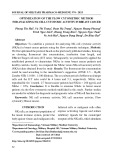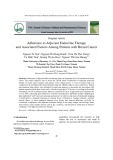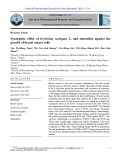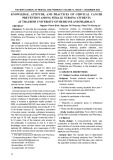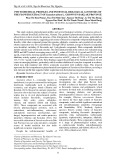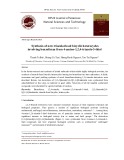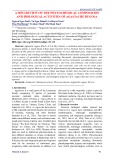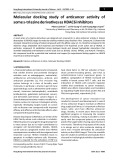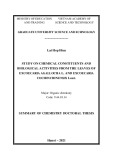Effect of gadolinium on the ryanodine receptor/ sarcoplasmic reticulum calcium release channel of skeletal muscle Sa´ ndor Sa´ rko¨ zi1, Csaba Szegedi1, Bala´ zs Luka´ cs1, Michel Ronjat2 and Istva´ n Jo´ na1
1 Department of Physiology, Research Center for Molecular Medicine, Medical and Health Science Center, University of Debrecen, Hungary 2 Laboratoire Ioniques et Signalization, DBMS, CEA, Grenoble, France
Keywords calcium channel; gadolinium; RyR1
Correspondence I. Jo´ na, Department of Physiology, Research Center for Molecular Medicine, Medical and Health Science Center, University of Debrecen, Debrecen, H-4012, Hungary Fax: +36 52 432289 Tel: +36 52 416634 E-mail: jonai@phys.dote.hu
(Received 10 September 2004, revised 10 November 2004, accepted 16 November 2004)
doi:10.1111/j.1742-4658.2004.04486.x
The effect of gadolinium ions on the sarcoplasmic reticulum (SR) calcium release channel ⁄ ryanodine receptor (RyR1) was studied using heavy SR (HSR) vesicles and RyR1 isolated from rabbit fast twitch muscle. In the [3H]ryanodine binding assay, 5 lm Gd3+ increased the Kd of the [3H]ry- anodine binding of the vesicles from 33.8 nm to 45.6 nm while Bmax, refer- ring to the binding capacity, was not affected significantly. In the presence of 18 nm [3H]ryanodine and 100 lm free Ca2+, Gd3+ inhibited the binding of the radiolabeled ryanodine with an apparent Kd value of 14.7 lm and a Hill coefficient of 3.17. In 45Ca2+ experiments the time constant of 45Ca2+ efflux from HSR vesicles increased from 90.9 (± 11.1) ms to 187.7 (± 24.9) ms in the presence of 20 lm gadolinium. In single channel experiments gadolinium inhibited the channel activity from both the cyto- plasmic (cis) (IC50 ¼ 5.65 ± 0.33 lm, nHill ¼ 4.71) and the luminal (trans) side (IC50 ¼ 5.47 ± 0.24 lm, nHill ¼ 4.31). The degree of inhibition on the cis side didn’t show calcium dependency in the 100 lm to 1 mm Ca2+ con- centration range which indicates no competition with calcium on its regula- tory binding sites. When Gd3+ was applied at the trans side, EGTA was present at the cis side to prevent the binding of Gd+3 to the cytoplasmic calcium binding regulatory sites of the RyR1 if Gd3+ accidentally passed through the channel. The inhibition of the channel did not show any volt- age dependence, which would be the case if Gd3+ exerted its effect after getting to the cis side. Our results suggest the presence of inhibitory bind- ing sites for Gd3+ on both sides of the RyR1 with similar Hill coefficients and IC50 values.
studies
[3]. Further
calcium from the sarcoplasmic reticulum (SR) [2], with the Kd for Gd3+ in the micromolar range. On neurons, Gd3+ blocked a part of the voltage sensitive Ca2+ cur- rent revealed that gadolinium blocks the voltage gated N-type [4], and T- and L-type Ca2+ channels [5]. The inhibitory effect of Gd3+ on SR Ca-ATPase, due to binding to the Ca-binding site, has also been described [6]. As a result of the high affinity of lanthanides to calcium binding sites, they have been named as ‘supercalcium’.
Earlier studies revealed that lanthanide ions have sev- eral physiological effects on different tissues and cells. These effects seemed to be related to Ca2+-dependent mechanisms and several studies describe direct effects of these ions on Ca2+-binding or calcium ion conduct- ing membrane proteins. Lanthanide ions were found to inhibit the twitch of toad skeletal muscle with effect- iveness depending on the ion radius. Among lanthan- ide ions gadolinium has the strongest inhibitory effect [1]. Gadolinum is also able to competitively displace
FEBS Journal 272 (2005) 464–471 ª 2004 FEBS
464
Abbreviations HSR, heavy sarcoplasmic reticulum; SR, sarcoplasmic reticulum; RyR1, skeletal type ryanodine receptor.
Effect of gadolinium on RyR1 S. Sa´ rko¨ zi et al.
[11] and Ma et al.
found activation of
the
Fig. 1. Effect of cis gadolinium on the ryanodine receptor. Single channel records were taken at )108 mV using symmetrical bathing solution having 50 lM free calcium concentration. The charge carrier was 250 mM KCl, and the channel openings were downward deflec- tions. Upper panel shows the control record with a Po ¼0.338. In the presence of 5 lM cis gadolinium the channel open probability decreases to 0.148 (middle panel) while increasing the gadolinium concentration to 8.3 lM, the channel openings were further reduced (lower panel) and characterized by Po ¼ 0.019 (o represents the open while c represents the closed state of the channel).
complex has a pKd of 12.6 [18], EGTA selectively binds Gd3+ below these circumstances. The open probability of the channel as a function of the cis gadolinium concentration (Fig. 2) was fitted by the Hill equation resulting in a half-inhibitory concentra-
The Ca2+ release channel ⁄ ryanodine receptor (RyR1) is regulated by several cytoplasmic ligands. It is activa- ted by millimolar concentrations of ATP and micromo- lar Ca2+, and inhibited by higher concentrations (> 100 lm) of Ca2+ and by millimolar Mg2+. Calmod- ulin existing in the cytoplasm directly regulates the channel in a Ca-dependent manner by activating the RyR1 at [Ca2+] < 1 lm and inhibiting at higher cal- cium concentrations [7,8]. The direct activation of the RyR1 by cytoplasmic Ca2+ shows a bell-shaped curve which suggests the presence of a high-affinity activating and a low-affinity inhibitory Ca2+-binding site on the channel [8,9]. A putative high-affinity calcium-binding site has already been found on the cytosolic site, close to the conducting pore [10]. Results about the effect of the luminal (trans) calcium on the activity of the RyR1 are controversial depending on experimental conditions. Inhibition of the channel was described at high luminal calcium levels by Fill et al. [12]. Sitsapesan & Williams observed that the channel was only regulated by the luminal calcium if it was first pre- activated by ATP and cyclic ADP-ribose (cADPR) on the cis side [13,14]. Tripathy et al. and Herrmann-Frank et al. have channel at 100–250 lm and inactivation at higher luminal calcium concentrations [15,16]. As the effect of the luminal cal- cium concentration was voltage-dependent and the acti- vation depended on the cis EGTA concentration in both cases the authors concluded that calcium ions regulate the channel activity by binding to cytosolic Ca-binding sites after flowing through the conducting pore. As Gd3+ can bind to the Ca2+-binding sites of different membrane proteins we investigated the effect of this ion on the RyR1 using different techniques [17].
Results
Single channel experiments
Fig. 2. Concentration dependence of the inhibitory effect of gado- linium from the cis side. Single channel recordings were taken at various cis gadolinium concentrations and open probabilities deter- mined using 30 s record segments. Data plotted as mean ± SE. Continuous line represents a Hill equation fitted to the data points having the parameters of IC 50 ¼ 5.65 lM and nHill ¼ 4.71. Number of experiments is shown at each point.
Figure 1 shows representative single channel records at control state and at different concentrations of Gd3+ applied at the cis side. During experiments gadolinium concentration was increased successively using stock GdCl3 solution. Gadolinium, in the micromolar con- centration range, decreased the probability of the channel opening; the channel openings apparently occured more rarely. At each concentration of gadolin- ium the effect has developed by the end of the experi- ment (< 30 s). At 13.3 lm Gd3+ the RyR1 was in its almost completely closed state (not shown). The inhibi- tion was reversible; after adding EGTA (equimolar with Gd3+) the channel almost completely regained its original activity (not shown). As the Gd–EGTA
FEBS Journal 272 (2005) 464–471 ª 2004 FEBS
465
Effect of gadolinium on RyR1 S. Sa´ rko¨ zi et al.
tion of 5.6 ± 0.3 lm for Gd3+ and a Hill coefficient of 4.7 ± 0.8.
the channel
Fig. 3. Effect of trans gadolinium on the ryanodine receptor. Single channel recordings were taken as described in Materials and meth- ods. Charge carrier was 250 mm KCl, and EGTA was applied on the cis side in order to immediately remove gadolinium ions that may have passed through the channel. Channel opening are down- ward deflections. (A) shows a control record in the absence of gadolinium characterized by Pocontrol ¼ 0.239. Effect of gadolinium (4.1 lM Gd3+, Po ¼ at different concentrations are shown in (B) 0.147) and (C) (9 lM Gd3+, Po ¼ 0.032). After addition of equimolar EGTA (9 lM) which chelates practically the total amount of previ- ously added gadolinium, the channel regains its original activity [(D) calculated Gd3+ concentration 12.3 nM, Po ¼ 0.21]. Further addition of EGTA to the cis side to reduce the cis Ca2+ concentration to 0.9 lM, results in a substantially decreased open probability (E). The channel pharmacology is fully preserved as shown by the effect of ATP [left side (F), 2 mM cis ATP, 2.54 lM cis Ca2+] and ryanodine [right side (F), 8 lM ryanodine]. All records are from one single experiment, the holding potential was )55 mV.
We have also tested the effect of Gd3+ on the lumi- nal side of the reconstituted channel. To decrease the possibility of the applied Gd3+ acting on the cytoplas- mic site of the RyR1 after (or during) passing through its conducting pore, the EGTA-Ca buffer was applied on the cis side. The calculated free calcium concentra- tion was equal on the cis and in the trans sides. On the other hand, voltage step measurements were made to see if the transmembrane potential difference had any affect on the inhibitory action of the Gd3+. Gd3+ inhibited the channel activity from the trans side in a concentration-dependent manner. (Fig. 3A–C). Decrea- sing the Gd3+ concentration on the trans side of the channel by addition of equimolar EGTA resulted in from the inhibition the recovery of (Fig. 3D) in less than one minute. The observation that the equimolar EGTA was able to completely restore the channel activity from the gadolinium inhi- bition within seconds, also strongly supports the idea that 100 lm EGTA total in the cis side prevents the binding of any Gd3+ ion to the regulatory calcium- binding sites located on the cis side of the RyR1. Fol- lowing the recovery, the pharmacology of the RyR1 was checked by its regulators to confirm that the chan- nel kept its integrity. Decreasing cis Ca2+ resulted in a decreased open probability (Fig. 3E), while successive additions of ATP cis increased the channel activity (Fig. 3F, first half of the record). At the end of the experiment ryanodine was added to the cis side which caused the channel to lock into its characteristic ‘half- open’ state (Fig. 3F, second half of the record). The the normalized open probabilities were average of plotted against the trans Gd3+ concentration (Fig. 4). Fitting the data points with the Hill equation gave a half-inhibitory gadolinium concentration of 5.4 ± 0.2 lm and a Hill coefficient of 4.3 ± 0.6. Open time histograms were constructed using the same rep- resentative current records from which the open proba- bilities were calculated. Histograms could be fitted in a satisfactory way by a single exponential. Representa- tive open time constant values of the RyR1s in the presence of Gd3+ cis and trans are shown in Tables 1 and 2, respectively. Gadolinium decreased the open time constant of the reconstituted ryanodine receptor in a concentration-dependent manner acting on either side. The decreased open time constant together with the decreased number of the open events led to the decrease of the open probability. The voltage-depend- ence of the inhibitory effect of the gadolinium was also investigated in four experiments. Gadolinium (2 lm) was applied at the trans side of the channel and cur-
rent records were acquired at different voltage steps. Open probability values were calculated and normal- ized in the absence of the gadolinium. The ratios of the normalized Po value to the average Po value during the individual experiments were plotted against the (Fig. 5). Data transmembrane potential differences regression (y ¼ points could be fitted by linear
FEBS Journal 272 (2005) 464–471 ª 2004 FEBS
466
Effect of gadolinium on RyR1 S. Sa´ rko¨ zi et al.
Fig. 4. Concentration dependence of the inhibitory effect of gado- linium from the trans side. Single channel recordings were taken at various trans gadolinium concentrations and relative open probabili- ties determined using 30 s record segments. To reduce individual variations relative open probabilities (Po ⁄ Pocontrol) at various trans gadolinium concentrations were calculated and plotted by normal- izing the data to the one obtained in the absence of gadolinium, which was determined at the beginning of each experiment. Data plotted as mean ± SE. Continuous line represents a Hill equation fitted to the data points having the parameters of IC50 ¼ 5.47 lM and nHill ¼ 4.31. Number of experiments is shown at each point. Fig. 5. Voltage-dependence of the inhibitory effect of gadolinium applied at the trans side. Relative (normalized for the control Po) open probabilities (Ponorm) were calculated at different transmem- brane potential differences (± 24.8, ± 38.4, ± 56.4, ± 71.3, ± 80.2, ± 110.1 mV) in the presence of 2 lM gadolinium trans. The ratio of the Ponorm values to the average of the Ponorm values during one experiment was plotted against the holding potential. Data points could be satisfactory fitted by linear regression (y ¼ A + B * x, dashed line), where A and B were found to be 1.00 ± 0.07 and 0.0016 ± 0.0009 mV, respectively.
Table 1. The effect of cis gadolinium on the open time constant of RyR1. T, Open time constant ± SE; N, number of experiments.
T (ms)1)
cis (lM)
Gd3+ N
the
0 3.33 5 6.67 0.99 ± 0.19 0.81 ± 0.13 0.57 ± 0.20 0.48 ± 0.05 14 8 6 5
Table 2. The effect of trans gadolinium on the open time constant of RyR1. T, Open time constant ± SE; N, number of experiments.
T (ms)1)
trans (lM)
Gd3+ N
increased from 100 lm to 1 mm in the presence of 4.5 lm Gd3+ cis (not shown), no significant change was observed in the channel activity (Po values nor- control were 0.011 ± 0.006 and malized for 0.005 ± 0.002 for 100 lm and 1 mm Ca2+ cis, respect- ively, where the number of experiment was three) which proves no competition beetwen Gd3+ and Ca2+ in this calcium contrentation range. EGTA (50 lm) applied consecutively in the cis side resulted in a slight but significant recovery of the channel from the inhibi- tion to a normalized Po value of 0.21 ± 0.18 (n ¼ 3), which is close to the characteristic Po value of the channel at 1 mm Ca2+ [19].
[3H]Ryanodine-binding and calcium efflux
0 3.33 5 7.5 1.06 ± 0.24 0.92 ± 0.44 0.55 ± 0.10 0.34 ± 0.09 20 6 5 3
A + B Æ X) where A and B were found to be 1.00 ± 0.07 and 0.0016 ± 0.0009, respectively, where y stands for the corrected Po and X for the Hp. As the fitting revealed no voltage-dependence of the inhibition this finding proves that gadolinium exerts its effect from the luminal side of the channel and does not penetrate to the cis side. The effect of changing cis calcium con- centration on the inhibitory effect of cis gadolinium was also investigated. When calcium concentration was
The effect of gadolinium on the ADP-caffeine induced calcium release from passively loaded HSR vesicles was measured by the rapid filtration technique. Figure 6 shows representative data points acquired from four representative rapid filtration experiments. The rate of release decreased in the presence of 20 lm Gd3+. This concentration of Gd3+ increased the time taken for cal- cium release without affecting the total amount of cal- cium released. The effect of 5 lm gadolinium on the [3H]ryanodine binding to the HSR was investigated at different ryanodine concentrations. Gadolinium (5 lm)
FEBS Journal 272 (2005) 464–471 ª 2004 FEBS
467
Effect of gadolinium on RyR1 S. Sa´ rko¨ zi et al.
Fig. 7. Gadolinium dependence of the ryanodine binding of the channel. Ryanodine binding in the presence of 18 nM [3H]ryanodine were determined at various gadolinium concentrations. Solid line represents the fitted curve using the Hill equation with kinetic parameters of Bmax ¼ 3.1 ± 0.1 pmolÆmg protein)1, Kd ¼ 14.7 ± 0.7 lM and nHill ¼ 3.16 ± 0.42. Each point represents the average of four independent measurements, while the error bars represent SE. component and (Amax ¼ 220.0 Bq
RyR1s were reconstituted into an artificial
Fig. 6. Effect of gadolinium on the calcium efflux from HSR vesi- cles. Vesicles were loaded passively in the presence of 45Ca. The total calcium concentration in the loading solution was 5 mM. Rapid filtration experiments were carried out in quadruplets and averages are shown. Circles represent the calcium efflux in the absence of gadolinium while the solid line is the fitted curve assuming one exponential T ¼ 73.5 ± 16.5 ms)1). Squares represent the calcium efflux in the presence of 20 lM gadolinium while the dotted line is the fitted curve assu- ming one exponential component (Amax ¼ 215.8 Bq and T ¼ 201.4 ± 25.5 ms)1).
increased the dissociation constant of ryanodine-bind- ing from 33.8 ± 3.2 to 45.6 ± 2.2 nm, while the value of Bmax did not change significantly.
The [3H]ryanodine-binding assay was carried out using HSR vesicles to study how Gd3+ modulates the Ca2+ release channel ⁄ ryanodine receptor residing in the SR membrane. Gadolinium was applied at differ- ent concentrations in the presence of 18 nm ryanodine and the amount of ryanodine bound was plotted against the concentration of the gadolinium (Fig. 7). Fitting of data points with the Hill equation revealed a Kd value of 14.7 ± 0.7 lm and a Hill coefficient (nHill) of 3.16 ± 0.42.
Discussion
lipid bilayer and the effect of gadolinium was investigated from the cytoplasmic and the luminal side in order to elucidate from which side gadolinium acts. In these single channel experiments Gd3+ inhibited the channel in a concentration-dependent manner on both sides. The half-effective concentrations were about 5 lm and the Hill coefficients were (cid:1) 4 for both sides. These findings support that there are four binding sites with similar affinity of gadolinium on the cytoplasmic and also on the luminal side of the channel. Although in single channel experiments the luminal Ca2+ concen- tration has an effect on the activity of the RyR1 [15,16], no luminal cation binding site has been des- cribed so far. As the regulatory effect of the trans calcium concentration was voltage-dependent and changed as the function of the cis EGTA concentra- tion, it was assumed that Ca2+ goes through the chan- nel from the luminal to the cytoplasmic side and binds to the regulatory calcium-binding sites residing on the cis side [16]. Several findings described in this paper are against the possibility that the luminal Gd3+ regu- lates the RyR1 after getting through the channel to the cis side. When gadolinium was applied on the trans side (in the absence of EGTA on the trans side), 100 lm EGTA was present on the cis side which forms a complex with the gadolinium ions if they get through the channel. The affinity of the Gd3+ compared to the EGTA is a million-fold larger than that of the Ca2+
The effect of Gd3+ was investigated on the function of SR Ca2+ release channel ⁄ ryanodine receptor complex. When the [3H]ryanodine-binding was examined as the function of the gadolinium concentration we found a Kd value of 14.7 lm and a Hill coefficient of 3.16 for the inhibition in the presence of 18 nm [3H]ryanodine. Chevallier et al. found a Kd value of 6.5 lm for the La3+ (ion which has similar properties to Gd3+) in competition with calcium for calcium-binding sites of rabbit sarcoplasmic reticulum.
FEBS Journal 272 (2005) 464–471 ª 2004 FEBS
468
1975 (revised in 1983). First, HSR vesicles were isolated from rabbit skeletal muscles (longissimus dorsii) according to the method described by Lai & Meissner [20]. Bands cor- responding to the HSR fractions were collected from the 36–38% region of continuous sucrose gradient, pelleted at 124 000 g for 60 min, resuspended in 0.4 m sucrose, 10 mm K+ ⁄ PIPES, pH 7.0 and were snap frozen in liquid nitro- gen, stored at )70 (cid:1)C for ryanodine-binding and calcium- flux measurements. Other portions of these HSR vesicles were instantly used for ryanodine receptor purification. The following protease inhibitors were also included throughout the preparation procedure to prevent proteolysis during isolation: 200 lm Pefabloc [4-(2-aminoethyl)-benzolsulfonyl- fluoride], 100 nm aprotinin, 1 lm leupeptin, 1 lm pepstatin A and 1 mm benzamidine. Protein concentration of HSR vesicles was determined according to the method of Lowry et al. [21], using bovine serum albumin as standard. Data expressed as mean ± SE.
Effect of gadolinium on RyR1 S. Sa´ rko¨ zi et al.
Purification of the ryanodine receptor complex
(Kd, Ca–EGTA ¼ 6.4, pKd, Gd–EGTA ¼ 12.9). No voltage- dependence of the inhibitory effect of the gadolinium was observed in the single channel experiments (Fig. 5) which should have happened when a cation current flows from the trans to the cis side. The fast recovery ((cid:1) 10 s) of the RyR1 from inhibition after adding EGTA to the trans side also makes it probable that the Gd3+ ions were removed from luminal binding sites of the channel. As the RyR1 displays high selec- tivity for cations over anions [11] the relatively large and at pH 7.2 negatively charged EGTA molecules cannot penetrate the pore of the channel. Experiments were carried out to investigate if there is any competi- tion beetwen the Gd3+ and Ca2+ in binding to high and low affinity calcium-binding regulatory sites of the RyR1. In three experiments, in the presence of 4.5 lm Gd3+ cis, elevating free Ca2+ concentration cis up to 1 mm didn’t result in any significant change in the Po of the channel (0.011 ± 0.006 for 100 lm Ca2+ and 0.005 ± 0.002 for 1 mm Ca2+). Consecutively applied 50 lm EGTA caused a slight recovery of the RyR1. This concentration of EGTA decreased the [Gd3+] to nominally zero whereas the calcium concentration decreased only by some tens of lm. The calculated open probability was characteristic for RyR1 at this calcium concentration [19]. As the EC50 for the cal- cium activation of the RyR1 is 9.37 ± 1.3 [19], using 1 mm calcium should have increased the activity of the channel if competition had occured. This observation means that cis Gd3+ doesn’t inhibit the channel by binding to the high affinity calcium-binding site. On the other hand there was no further decrease in the activity of the channel when higher cis calcium concen- trations were applied which makes it unlikely that gadolinium binds to the low affinity inhibitory cal- cium-binding site. Appling calcium concentrations higher than 1 mm would significantly worsen the signal to noise ratio because Ca2+ (for which the RyR1 has much lower conductance than for K+) is performing a larger role as a current carrier. Our results suggest that there are sites on the cis and trans side of the RyR1 that are able to bind gadolinium in a reversible and concentration-dependent manner causing the inhibition of the channel with similar Hill coefficient and IC50 values. The cis-binding sites seem not to be identical with the known cis calcium-binding regulatory sites.
HSR vesicles (3 mgÆmL)1) were solubilized for 2 h at 4 (cid:1)C with 1% (v/v) CHAPS in a solution containing 1 m NaCl, 100 lm EGTA, 150 lm CaCl2, 5 mm AMP, 0.45% phos- phatidylcholine, 20 mm Na ⁄ PIPES, pH 7.2, protease inhibi- tors as in the previous step, and additionally 1 lm calpain inhibitor I (N-acetyl-leu-leu-norleucinal) and 1 lm calpain inhibitor II (N-acetyl-leu-leu-methionial) were also included. The extent of ryanodine receptor solubilization and the subsequent migration distance of the solubilized receptor in the sucrose gradient was monitored by labeling one part of the solubilized sample with [3H]ryanodine. Insoluble pro- teins were removed by centrifugation at 59 000 g, and sub- sequently the resulting supernatant was layered on the top of 10–28% sucrose gradients containing 1% (v/v) CHAPS, 0.7 m NaCl, 3.3 mm AMP, 0.5% (w/v) phosphat- idylcholine, 70 lm EGTA, 100 lm CaCl2, 1 mm dithiothrei- tol, 13 mm Na ⁄ PIPES, pH 7.2 and all protease inhibitors as used before. Unlabelled and [3H]ryanodine-labeled solu- bilized SR membranes were centrifuged through identical sucrose gradients for 16 h at 90 000 g (4EC) in a swing-out (SW-27) Beckman rotor (Beckman Inc., Fullerton, CA, USA). Fractions of the unlabelled gradient corresponding, by sucrose density, to the peak of the [3H]ryanodine-labeled receptors were collected, rapidly frozen in liquid nitrogen and stored at )70 (cid:1)C until further use. Aliquots of the HSR vesicles and fractions of the solubilized receptor col- lected from the sucrose density gradient were visualized by SDS ⁄ PAGE using Laemmli type 10% linear gel for the visualization of the protein composition of the fractions.
Materials and methods
Isolation of heavy SR vesicles
Ryanodine-binding
Procedure to obtain muscle was in accordance with the eth- ical standards as formulated in the Helsinki declarations of
Ryanodine-binding assays were carried out using [3H]ry- anodine in a medium having the composition of 1 m NaCl,
FEBS Journal 272 (2005) 464–471 ª 2004 FEBS
469
through an eight pole low-pass Bessel filter and digitized at 3 kHz, using Axon Instruments (Union City, CA, USA) hardware and pclamp 6Æ3 software. Channels with conduct- ance higher than 460 pS were accepted as RyR1s. Open probability values (Po) were calculated from representative data segments of 10–90 s duration. Total recording time in each experiment was more than 5 min for the experimental condition tested. This time duration appeared to be enough to reach the equilibrium of the channel parameters. Tem- perature of the bilayer chamber was 22–25 (cid:1)C during meas- urements and concentration values of ionized (‘free’) Ca2+ were calculated using the computer program and binding constants published by Fabiato [22].
Effect of gadolinium on RyR1 S. Sa´ rko¨ zi et al.
Materials
25 mm Na ⁄ PIPES pH 7.1, 1 mm Pefabloc, 100 lm CaCl2, resulting in about 100 lm of ionized free calcium concen- tration. Aliquots (50 lL) containing 25 lg protein were incubated at 37 (cid:1)C for 120 min, with various concentrations of the radioligand, as indicated in the figure legends. For measurements of gadolinium effect, the Gd3+ were added 30 min before the addition of tritiated ryanodine. The reac- tion was terminated by filtering the samples on BIO-DOT 96 well filter apparatus using Millipore 50 filter paper (Billerica, MA, USA). This was followed by washing the dots with equal aliquots of washing medium identical to the incubation medium except that ryanodine (hot and cold) was omitted. Nonspecific binding was determined in the presence of 50–100 lm ryanodine, which had been added to the incubation mixture prior to the radioligand. Filter papers were cut into appropriate pieces and their radioactivity was determined using a liquid scintillation counter (Beckman Inc.). Binding data were fitted using ori- gin software and the Scatchard equation.
45Ca2+ flux measurements
Protease inhibitors were purchased from Boehringer (Mannheim, Germany), from Merck (Darmstadt, Germany) and from Sigma (St. Louis, MO, USA), lipids were obtained from Avanti Polar Lipids (Alabaster, AL, USA), [3H]ryanodine was from DUPONT (Boston, MA, USA), SDS, polyacrylamide gel components, and molecular mass standards were from Bio-Rad Laboratories (Hercules, CA, USA). All other chemicals were from Sigma.
Acknowledgements
HSR vesicles (1.45 mgÆmL)1) were passively loaded for 1 h at room temperature in a medium containing 250 mm KCl, 20 mm K ⁄ MOPS pH 7.2, 5 mm CaCl2 including 45Ca2+. Vesicles were spread on filter papers type: DA, pore size: 0.65 lm. Calcium efflux was initiated for time duration of 25–200 ms by the stream of measuring buffer containing 250 mm KCl, 20 mm K ⁄ MOPS, 5 mm ADP, 5 mm caffeine, pH 7.2, with or without 20 lm GdCl3. The radioactivity remaining on the filter was determined by liquid scintilla- tion method.
Planar lipid bilayer measurements
This work was supported by a grant form the Hungar- ian Research Found (OTKA T 037727 and TS 040773), by the Hungarian Ministry of Health (015 ⁄ 2001) and by the European Union (HPRN-CT-2002-00331). We also thank Prof. Varda Shoshan-Barmatz of Ben Gurion University for her valuable help and suggestions in the experimental design and evaluation. Cs. Szegedi is a Boyai Fellow.
References
1 Hambly BD & Dos Remedios CG (1977) Responses of skeletal muscle fibres to lanthanide ions. Dependence of the twitch response on ionic radii. Experientia 33, 1042– 1044.
2 Chevallier J & Butow RA (1971) Calcium binding to
the sarcoplasmic reticulum of the rabbit skeletal muscle. Biochemistry 10, 2733–2737.
3 Docherty RJ (1988) Gadolinium specifically blocks a component of voltage sensitive calcium current in neuroblastoma x glioma hybrid cells. J Physiol 381, 69P.
4 Docherty RJ (1988) Gadolinium selectively blocks a
component of calcium current in rodent neuroblastoma x glioma hybrid (NG108-15) cells. J Physiol 398, 33–47. 5 Biagi BA & Enyeart JJ (1990) Gadolinium blocks low- and high-threshold calcium currents in pituitary cells. Am J Physiol 259, C515–C520.
CHAPS solubilized ryanodine receptor molecules were incorporated into planar lipid bilayer of the Mueller–Rudin type. The bilayer was formed across a 250 lm aperture from a mixture of l-a-phosphatidylethanolamine, l-a-phos- phatidylserine and l-a-phosphatidylcholine in the ratio of 5 : 4 : 1 dissolved in n-decane (20 mgÆmL)1). Reconstitu- tion was initiated in symmetric solution (250 mm KCl, 50 lm free Ca2+, 20 mm PIPES, pH 7.2), when the gado- linium was applied at the cis side. In experiments when the effect of gadolinium from the trans side was investigated, Ca ⁄ EGTA buffer was used at the cis side [150 lm CaCl2, 100 lm EGTA cis (free Ca2+ ¼ 50 lm); 50 lm Ca2+ with- out EGTA trans]. Small aliquots of the solubilized receptor were added to one side of the bilayer chamber defined as the cytoplasmic (cis) side, meanwhile the other chamber was regarded as luminal (trans) side. Measurements were carried out under voltage clamp conditions, the holding (Hp) was referred to the trans chamber as a potential ground. Successful incorporation was detected as stepwise increase in current. Electrical signals were filtered at 1 kHz
FEBS Journal 272 (2005) 464–471 ª 2004 FEBS
470
6 Jona I & Martonosi A (1986) The effects of membrane potential and lanthanides on the conformation of the Ca2+-transport ATPase in sarcoplasmic reticulum. Biochem J 234, 363–371.
14 Sitsapesan R & Williams AJ (1995) Cyclic ADP-ribose and related compounds activate sheep skeletal sarco- plasmic reticulum Ca2+ release channel. Am J Physiol 268, C1235–C1240.
7 Tripathy A, Xu L, Mann G & Meissner G (1995)
Calmodulin activation and inhibition of skeletal muscle Ca2+ release channel (ryanodine receptor). Biophys J 69, 106–119.
15 Tripathy A & Meissner G (1996) Sarcoplasmic reticu- lum lumenal Ca2+ has access to cytosolic activation and inactivation sites of skeletal muscle Ca2+ release channel. Biophys J 70, 2600–2615.
8 Buratti R, Prestipino G, Menegazzi P, Treves S &
Zorzato F (1995) Calcium dependent activation of skel- etal muscle Ca2+ release channel (ryanodine receptor) by calmodulin. Biochem Biophys Res Commun 213, 1082–1090.
16 Herrmann-Frank A & Lehmann-Horn F (1996) Regula- tion of the purified Ca2+ release channel ⁄ ryanodine receptor complex of skeletal muscle sarcoplasmic reticu- lum by luminal calcium. Pflu¨gers Arch 432, 155–157. 17 Sarkozi S, Szegedi C & Jona I (2000) Effect of gadoli-
nium on the ryanodine receptor-calcium release channel. J Physiol 526P, 40P.
18 Martell AE & Smith RM (1974) Critical Stability Con-
9 Sarkozi S, Szegedi C, Szentesi P, Csernoch L, Kovacs L & Jona I (2000) Regulation of the rat sarcoplasmic reti- culum calcium release channel by calcium. J Muscle Res Cell Motil 2000, 131–138.
10 Chen SR, Zhang. L & MacLennan DH (1993) Antibo- dies as probes for Ca2+ activation sites in the Ca2+ release channel (ryanodine receptor) of rabbit skeletal muscle sarcoplasmic reticulum. J Biol Chem 268, 13414– 13421.
stants. In Inorganic Complexes, Vol. 4, (Sigel A, ed.), pp. 37, 56–57, 269. Plenum Press, New York and London. 19 Sarkozi S, Szegedi C, Szentesi P, Csernoch L, Kovacs L & Jona I (2000) Regulation of the rat sarcoplasmic reti- culum calcium release by calcium. J Muscle Res Cell Motil 21, 131–138.
11 Fill M, Coronado R, Mickelson JR, Vilven J, Ma JJ,
Jacobson BA & Louis CF (1990) Abnormal ryanodine receptor channels in malignant hyperthermia. Biophys J 57, 471–475.
20 Lai FA & Meissner G (1990) Structure of the calcium release channel of skeletal muscle sarcoplasmic reticu- lum and its regulation by calcium. Adv Exp Med Biol 269, 73–77.
12 Ma J, Fill M, Knudson CM, Campbell KP & Coronado R (1988) Ryanodine receptor of skeletal muscle is a gap junction-type channel. Science 242, 99–102.
21 Lowry OH, Rosenbrough NJ, Farr AL & Randall RJ (1951) Protein measurement with the Folin phenol reagent. J Biol Chem 193, 265–275.
22 Fabiato A (1988) Computer programs for calculating
13 Sitsapesan R & Williams AJ (1995) The gating of the sheep skeletal sarcoplasmic reticulum Ca(2+)-release channel is regulated by luminal Ca2+. J Membr Biol 146, 133–144.
total from specified free or free from specified total ionic concentrations in aqueous solutions containing multiple metals and ligands. Methods Enzymol 157, 378–417.
FEBS Journal 272 (2005) 464–471 ª 2004 FEBS
471
Effect of gadolinium on RyR1 S. Sa´ rko¨ zi et al.




